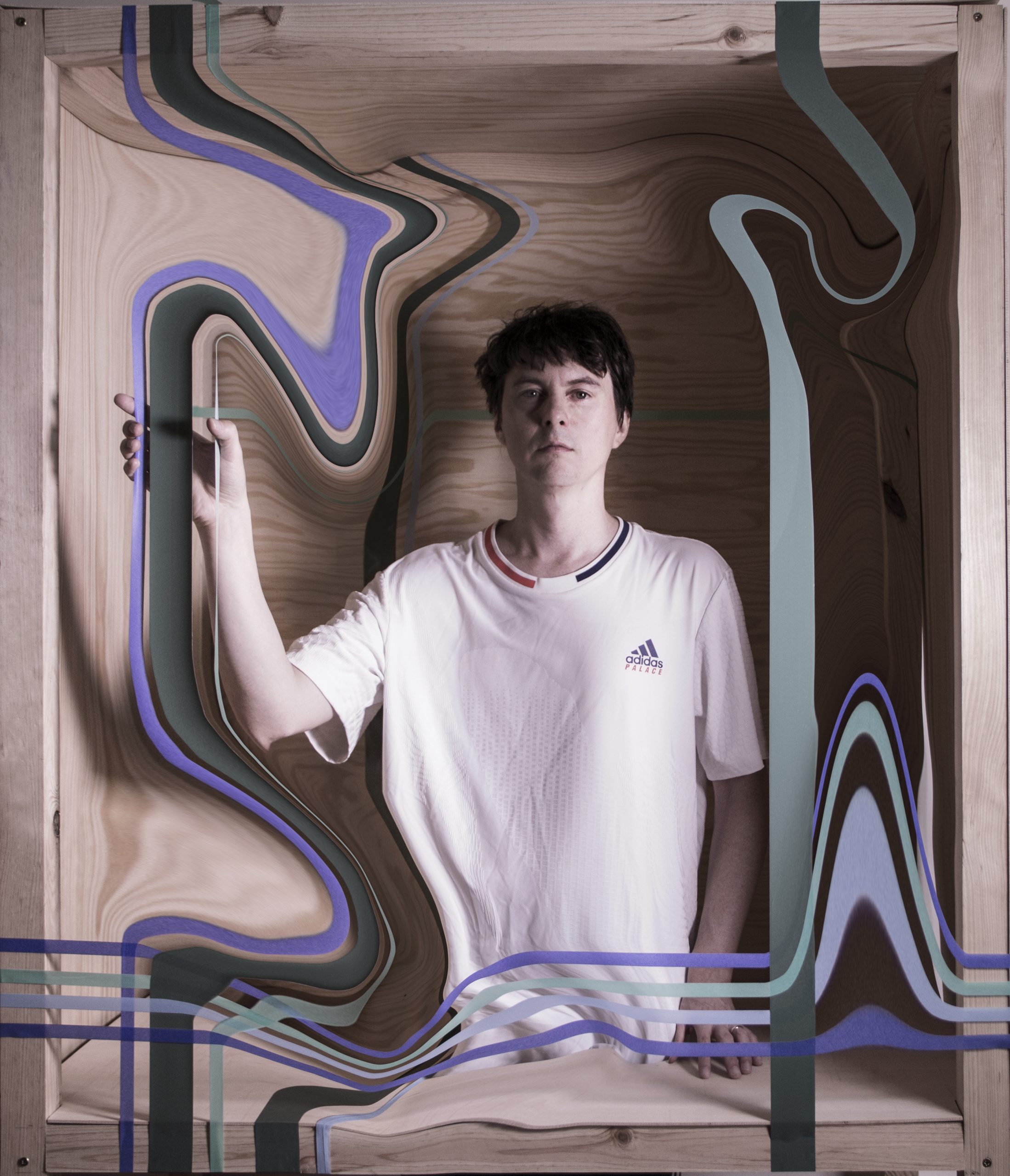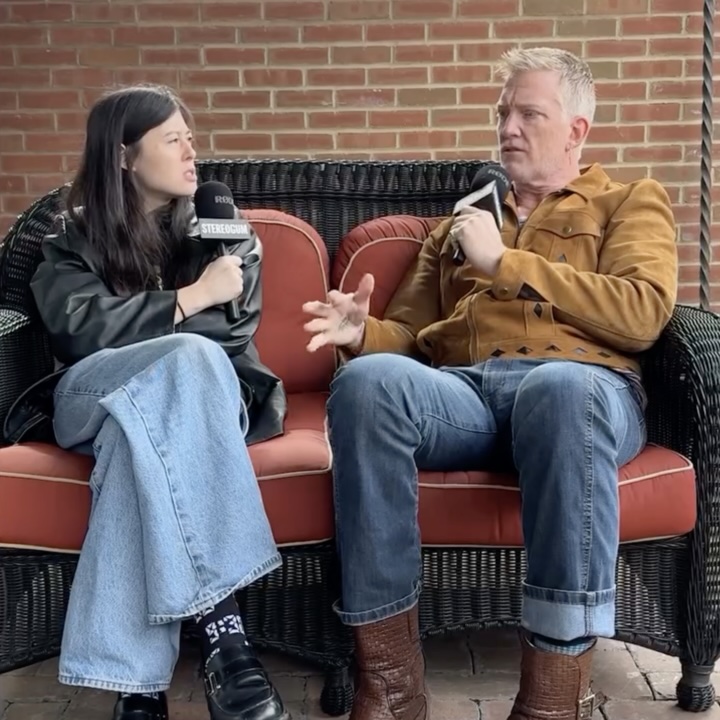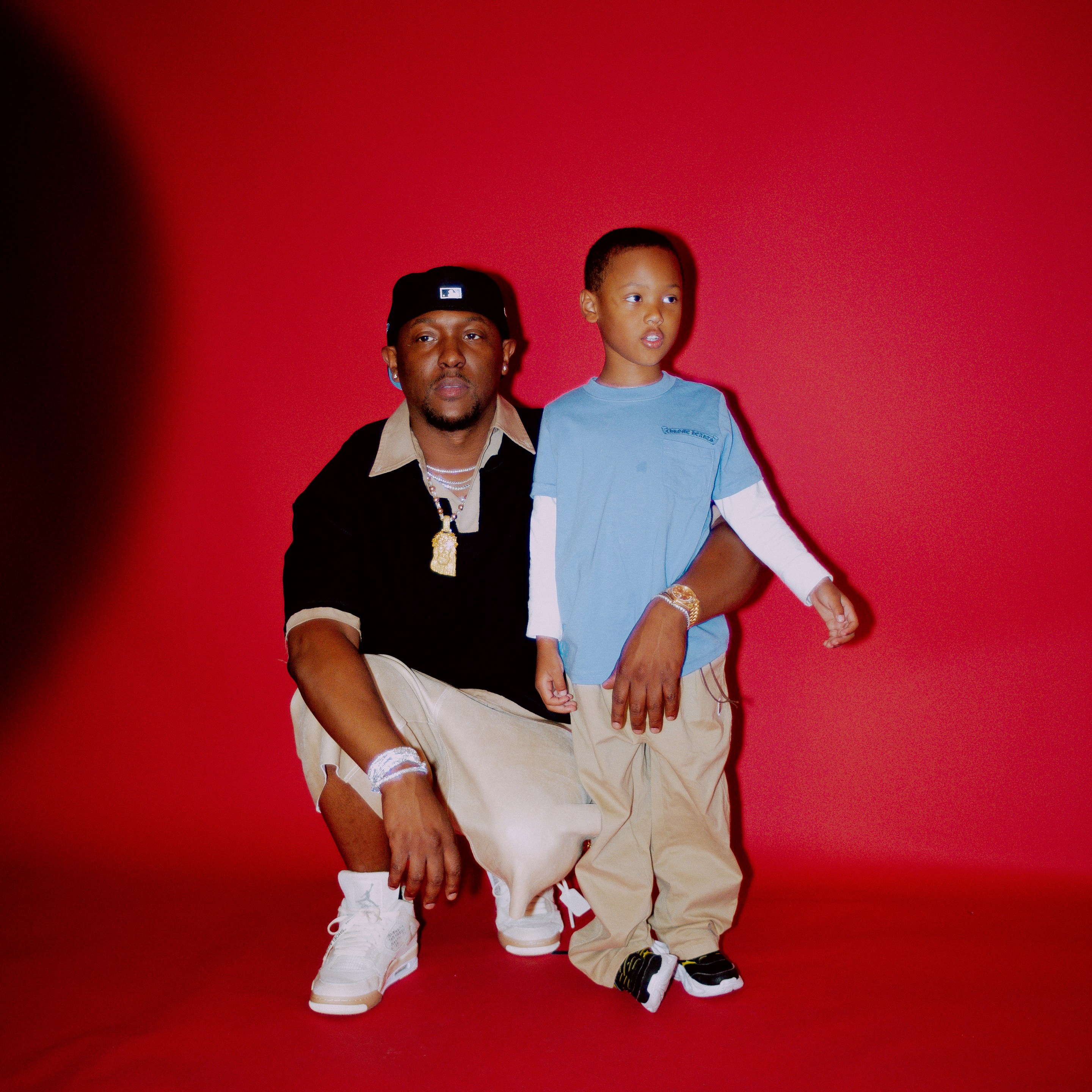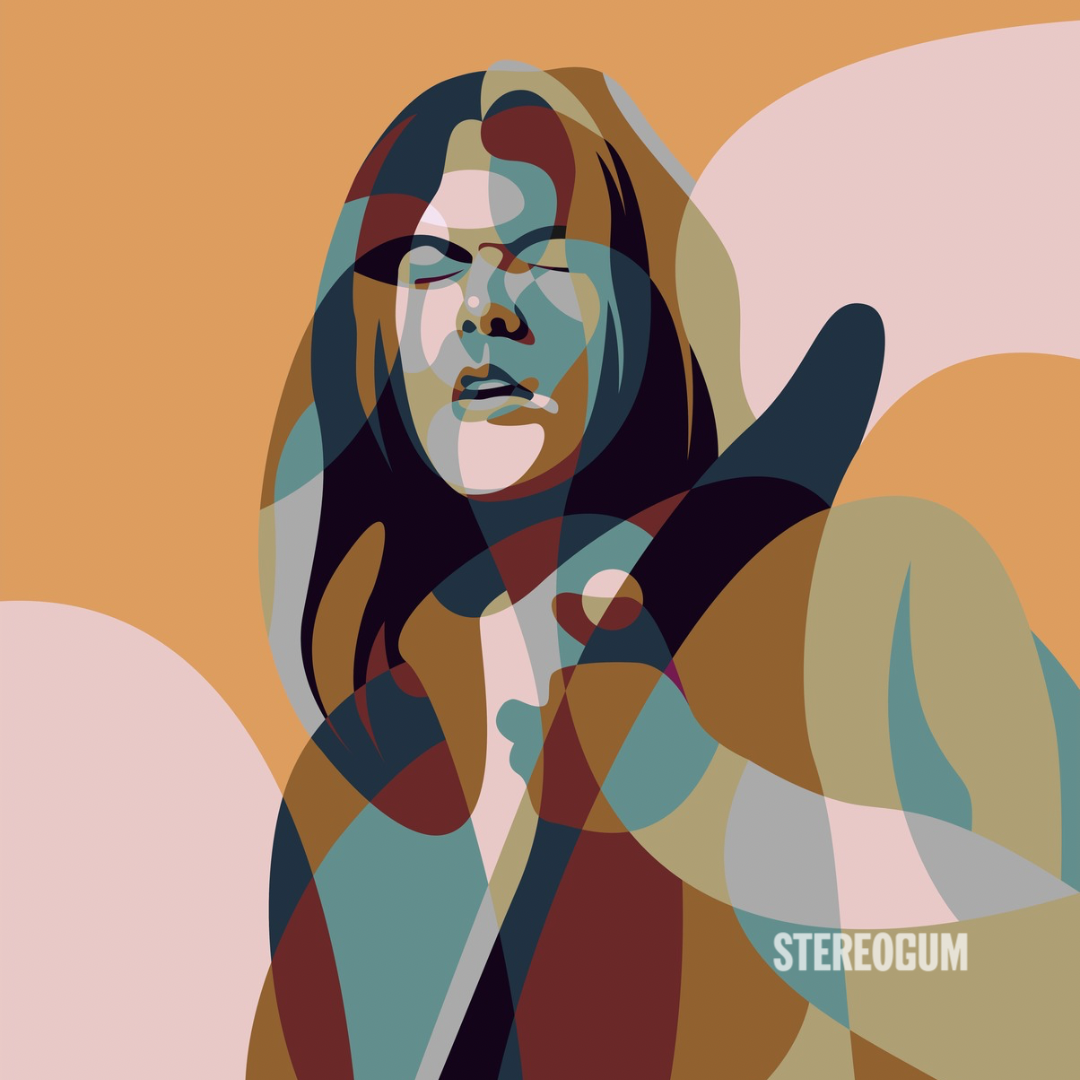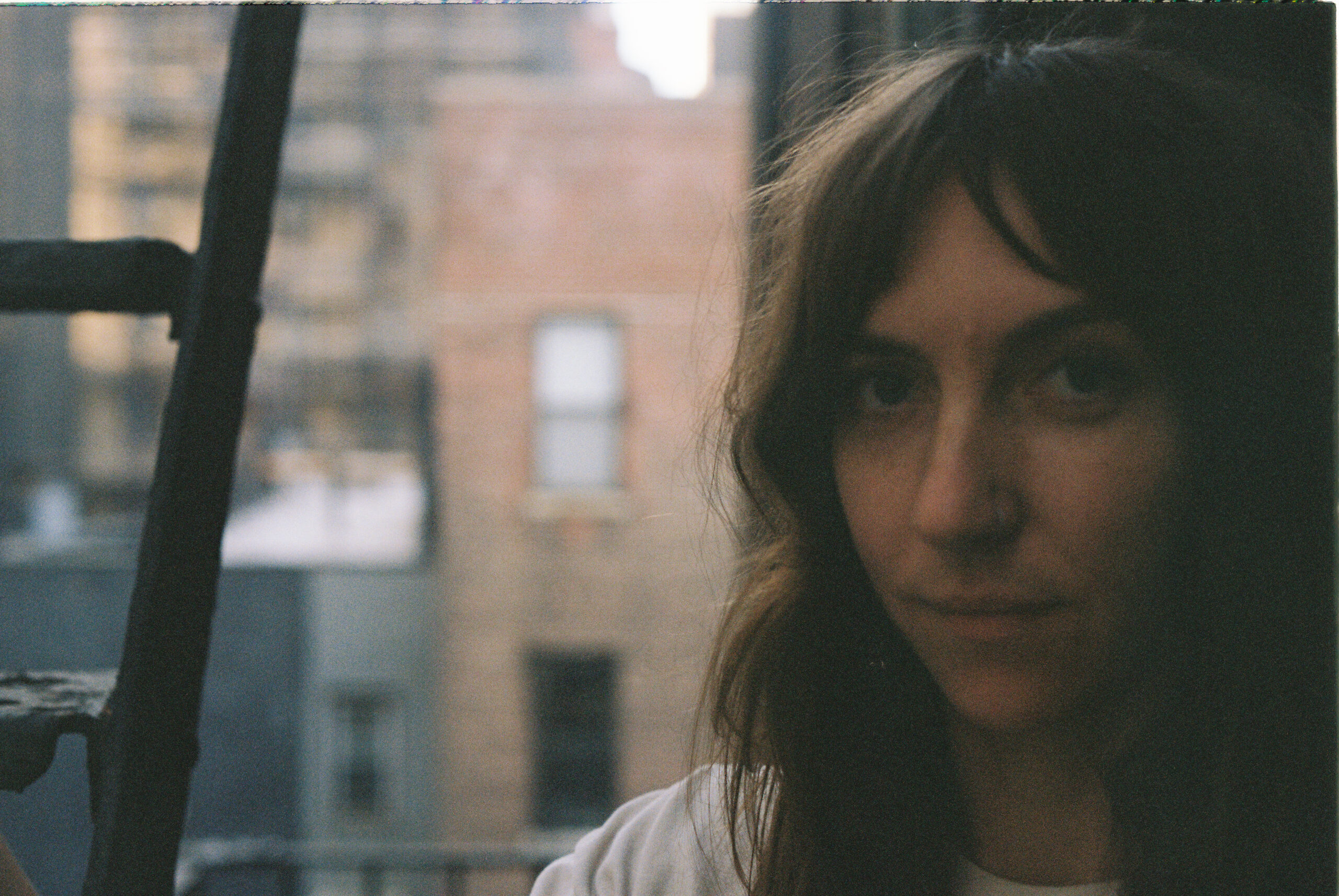When Noah Lennox began writing his new solo album, Buoys, he started with just a guitar. Though previous Panda Bear albums have emerged this way, they've resulted in increasingly widescreen visions such as 2011's Tomboy and the euphoric glow of 2015's Panda Bear Meets The Grim Reaper. But Buoys feels different because its skeletal framework is still audible throughout this album. The rough guitar strokes and surprisingly raw vocals (voice stacking, one of the iconic Panda Bear touches, has been completely abandoned) are the backbone of Lennox's most stripped-down set of songs since Young Prayer. It is the some of the most delicate music of his career.
That is not to say that this is a headphones album. Play Buoys on speakers -- big speakers -- and something miraculous happens. Songs that seem fragile get tossed around in a vast ocean of sub-bass and textural aquatic effects. Lennox's voice, carefully shaded with Auto-Tune, carries a newfound resonance and power. The climax on stand-out track "Token" surges like a jet engine with the power of Person Pitch, while the title track and the gentle burn of "I Don't Know" recall "Surfer's Hymn." Experiment with the ways you listen to it and Buoys can either flicker like a candle or explode like a firework.
This is the effect of Lennox's immaculate mixing and engineering, which takes a heavy influence from traditional dub music. If Person Pitch crystallized all of Animal Collective's psychedelic bliss up to that point through sample-driven turntable music, Buoys does something similar with traditional soundsystem music. This is due in part to co-producer Rusty Santos, who has often been mentioned for his production role in Panda Bear's breakthrough and Animal Collective's early work such as Feels and Sung Tongs. What's overlooked is what Santos has done since: opening for the xx with his former band the Present and engineering key releases for everyone from Chicago footwork pioneer DJ Rashad to Beijing rapper Howie Lee to Príncipe Discos, the Lisbon-based label that has rocketed the city's batida dance music to the cutting edge of club music around the world. Santos' built up the web of disorienting sound effects that orbit Buoys and brought in key collaborators like reggaeton DJ Lizz (who Lennox considers a co-arranger for providing the crying on "Inner Monologue" and suggesting the pristine water drops on "Dolphin") and Portuguese singer Dino D'Santiago.
I met Lennox in a café in Brooklyn for a wide-ranging discussion of Buoys. Sipping beers in the warm sunlight on an otherwise brutally cold winter day, just south of the nearly unrecognizable Williamsburg where Lennox once lived and became a key artist, we discuss how the new album echoes Panda Bear's previous albums while simultaneously marking a departure. Read our Q&A below.
STEREOGUM: How was it to play Sung Tongs live again after so many years?
PANDA BEAR: It was more fun than I thought it would be. It was hard because I had to retrain my hand how to do it, because I hadn't really played guitar very much, and certainly not acoustic guitar, which is a little bit more labor intensive as far as muscles and stuff. It was because I'd started doing that, that I started to write little songs while I was practicing for the Sung Tongs. The tuning on the guitar is the same as my Sung Tongs tuning.
STEREOGUM: Did you have any clear intentions going into record this new album?
PANDA BEAR: I knew there were a handful of things that I didn't want to do. I hoped the absence of that would make something kind of new for me. Maybe not new for the world, but new for me. I also figured one of the things that was attractive about working with Rusty was hearing him talk about the kind of stuff he was making and where his head was at with music and production, namely sad trap, Latin trap, reggaeton, stuff like that. I was like, "I wonder how the songs that I'm doing filtered through that perspective would sound?" I just thought that, coupled with the fact that I was going to forbid myself from doing certain techniques that I felt like I'd taken to the end of the road, it would push me into some kind of new space, which I was really interested in doing.
STEREOGUM: How did you end up reconnecting with Rusty?
PANDA BEAR: He came to Lisbon, I think to work with Dino [D’Santiago], or maybe something on my friend Nelson's label, called Príncipe. Do you know them?
STEREOGUM: I’m a very big fan, I actually have a question a little bit later.
PANDA BEAR: I think he was doing some work with one of their artists. My friend Rita, she sent me a photo that was her and Rusty. I just figured she had seen him somewhere in the world. To me, Rusty lived in New York. I didn't know he was in Lisbon. She's like, "No, I'm with him right now." I was like, "I haven't seen him in six years. Let's hang out."
STEREOGUM: Getting into Buoys, it's a very different record based on whether you're listening on headphones or on a sound system.
PANDA BEAR: For sure.
STEREOGUM: On headphones it sounds small and intimate, then when you put it on big speakers it's huge. Did you think a lot about how people were going to listen to it?
PANDA BEAR: We figured -- I hope it's not the majority, but it must be close -- that most would listen on laptop speakers or earbuds that couldn’t really represent a lot of the deeper, lower stuff. At a certain point you've got to decide which thing you're making. Are you going to make something that is optimized for every experience, or are you going to choose an adventure, so to speak? Ultimately we tried to make it sound less rooted, when it's on the laptop speakers. It's a bit more dreamy to me. It's a little bit more … not ambient, because I feel like the rhythms are there, but it's more suggested. The rhythmic quality of the music is more suggested than represented in that listening experience. For me, the full picture was with the sub stuff in it. There's no kick drums, really. Maybe "Cranked" in the second verse has a kick drum in it, but there's very few kick drums.
STEREOGUM: That track especially reminds me more than anything of dub music.
PANDA BEAR: For sure.
STEREOGUM: It got me thinking about how Panda Bear Meets The Grim Reaper has that King Tubby reference in the title, and more than anything this album reminds me of King Tubby and Lee "Scratch" Perry. Old dub albums. What is your relationship with dub and sound system music?
PANDA BEAR: Dub production is perfect sounding music to me. To me, the contemporary equivalent is trap music, actually. In terms of the architecture, it's similar elements, but pushed to extremes. In dub music you had a bass guitar that was deep, but it wasn't sub deep. It feels like that element in trap music has just been pushed deeper. Then the hi-hat stuff in dub music is now digital, either samples or drum machines, that feels a bit sharper and a bit more pushed to the ceiling. At least my perspective of it is the space of the recordings is defined by the reverbs and the delays, and how those elements that are at the top and the bottom are played with throughout the piece of music. Trap operates in a very similar way to me. I know it doesn't sound like a trap record, but when I think just of the sonics of the thing, it's really a mirror image of a trap setup. I agree with you as far as it feeling like an extension of dub production. Being such a fan of that style, I'm certainly happy to hear that.
STEREOGUM: When you were working in the demos you said you started with acoustic guitar. How did you get from acoustic guitar to here?
PANDA BEAR: Rusty. As soon as he was talking about, "This is the kind of stuff I'm working on," I wanted to push the thing more in that direction. I don't know where we're going, but I know it's going to be somewhere in that neighborhood. I should say the demos that I made, it was a singing part, a guitar part, and then some sort of crude drum machine-y part. There was this electronic or engineered element to the songs, even before Rusty. Rusty introduced basically 808 samples that we would just tune to the song, almost like playing a bass.
Once we found that method, we just applied that to every song. Those were the three elements we zeroed in on. One was the guitar. One was the voice. Because once we found those three elements, it was all about how can we make it interesting just using these three flavors? How can we treat those three things in the song to create some sort of emotional or sonic narrative? Because the lyrics themselves aren't particularly narrative in any way. It's more collage-y or impressionistic. I hoped that these phrases would stick in people's mind, like voices in their head, like stuff they would say to themselves, but they're not really telling stories in any way.
STEREOGUM: Family has always been a focal point lyrically in your albums. You've written songs about your dad and your wife and your kids over many records. Do those subjects come into this record?
PANDA BEAR: It's the same, but instead of me talking about family, the family, it's the global family. It sounds so cheesy, but that’s basically what it is. I'm trying to talk in some kind of intimate, caring way, about everybody.
STEREOGUM: That's interesting because this does feel like the most collaborative solo album you've made. What was it like bringing in other singers?
PANDA BEAR: It was cool in a way that working with a band is cool, in that people bring their own unique perspective and think of things that you would never think of. It can surprise you in ways that I find really exciting. I can say in Dino's case, he's way more a pro singer. It's a bit humbling to watch him come in and just first-take everything. He came in and he knew exactly where in the song he was going to do his thing. Liz also gets a co-arrangement credit because Rusty played everything for Liz, she had one idea per song. She was like, "That song should have crying. That song should have a water drop in it." I'm not sure that every idea made it through to the final phase, but a lot of them did. It's stuff that we never would've thought of.
STEREOGUM: It's interesting you mention the crying and how certain melodies echo other certain tracks. The crying was one of the things where it brought me back to Person Pitch, with "Bros" which has that crying sample. In a lot of ways this record brought me back to Person Pitch for the first time.
PANDA BEAR: I thought so too, beyond Rusty.
STEREOGUM: Completely. Why do you think that is?
PANDA BEAR: It has a very different aesthetic than that. I agree with you. I feel like it does, but it's hard for me to define the connections beyond, "Rusty worked on it." That's the link.
STEREOGUM: The best way I've been able to figure it out in my head is Person Pitch was so much like a turntable record, and this to me is that, but for sound system music.
PANDA BEAR: What do you mean by that?
STEREOGUM: In the way it's pulling all of these samples together. Person Pitch feels almost more like a collection of tracks, something you would pick one from during a DJ set. That's how I always think of that record.
PANDA BEAR: This one feels more the opposite of that. Like all the pieces fit together. All the songs are a puzzle piece that build this image at the end in a way Person Pitch doesn't. I think this record and that record felt like departure points for me creatively. Person Pitch felt like the start of something new and this one does too. I'm sure that's not to everybody's taste. I would imagine that won't please everybody, but that's OK.
STEREOGUM: In an old interview talking about Lisbon, you said you felt connected with the city because you're "a slow moving person" and Lisbon is "a slow moving city."
PANDA BEAR: Yeah, it feels like it's speeding up.
STEREOGUM: Exactly, Lisbon feels like it's speeding up a lot. You've been there for almost 15 years, well before things felt like that.
PANDA BEAR: Yeah, it's only started speeding up, I'd say, six or seven years ago.
STEREOGUM: What has that been like to see? How has the city changed for you?
PANDA BEAR: It feels like I'm going through it a second time, like when I came to Brooklyn it had already started revving up here. I feel like I moved here after it had started and I left before it was finished. Maybe it's still not finished. I don't know. I do feel like I've seen something like it before, as far as a place just getting a lot of attention, and people come in, and people get pushed out. That seems like what's happening in the city. It's a bummer in some ways, but there's also positive things about it. I try to focus on some of that stuff too because most of the young folks I know are like, "Ugh," about it. I get it. It feels like the old Lisbon is dead or dying in some ways. I try to encourage them, being like, "You can shape the Lisbon that you want now." It feels like it's growing into something, but it hasn't crystallized yet. It feels like an opportunity for these people who are part of the culture there to shape it as they would like to see it. I think that's a possibility.
STEREOGUM: You mentioned the Lisbon label Príncipe. How did you get introduced to Príncipe and batida music?
PANDA BEAR: Through my friend [Príncipe co-founder] Nelson [Gomes]. They started playing DJ Marfox records and I was just like, "I've never heard anything like this before." That's always the music that resonates most with me, is when I can't really trace where something comes from. I find that really exciting, I guess. I was on board as soon as I heard Marfox. It's been a really consistent output of good stuff. The nights they do are amazing. Often they do them at Music Box, which is a maybe 150-capacity place down near the river. It's usually about seven or eight people DJ-ing or performing. Almost always packed. It's super high energy, really, really fun. It’s one of the best things musically in the city, for sure.
STEREOGUM: Your singing is so direct on Buoys. In some past records your singing would be lower in the mix or blend into things. Here, it’s exciting how forward it is and reminds me more of your live shows. How did you approach singing on this album?
PANDA BEAR: One of the things I knew I didn't want to do for this one was use my techniques or tricks for recording vocals in the past. Which is to say a lot of stacking and harmonies. It kind of feels like I was trying to get the vocal to sound more like mist or a cloud, or a ball of yarn in the mix. It's this really fuzzy thing. The new thing feels more like a piece of plastic. It's got much harder edges, but it's not quite metallic. It's not that sharp. It definitely feels more tactile. I wanted to do something that felt more intimate in terms of the relation of the voice and the listener. I knew I wanted to do a single vocal take. I'd been trying to do something like that for a while.
On A Day With The Homies, I first started those songs as a single vocal and just couldn't get it to sound good to me. Homies feels like the bridge between Buoys and the previous three. Rusty suggested the Auto-Tune thing, and that was part of it, because there's a certain thickness and resonance that it gives my voice that sort of achieved it, like halfway what I was looking for. I think "Dolphin" was the first time we figured out that perspective on it, and then just applied it to all the songs after that. That's why I wanted "Dolphin" to be the first song. It felt like the first moment that we defined what the rest of the thing became. It makes it very clear, if you're not on board with this then don't waste your time.
STEREOGUM: Do you think your live set up for these songs will be different than previous performances?
PANDA BEAR: I would like to. I have a plan at some point ... I don't think I'm going to be able to do it this year. This year I'll play it in more the way that I've been doing for the past five years or so, which is to say, two samplers. To me, it sits in a place between DJ-ing and live performance. It's not fully either of those things, but it draws from both of those places. I'm essentially DJ-ing my own stems and singing over top of it, more like toasting, again, more of a dub thing. I have this vision of doing things like Violent Femmes, something like that. Acoustic guitars with a bass player and a drummer, a simple kit. Maybe I can get that together, but this year's going to be more Animal Collective-focused. I doubt I'll get to that until next year.
STEREOGUM: With touring or recording?
PANDA BEAR: Yeah, touring. I'd like to play Buoys start to finish with that setup. I'm sure we'd do weird stuff with it. I don't think I'd play it straight. I'm sure we'd expand on certain parts, or probably have more extended sections of various songs, because we couldn't do a lot of the fuckery that the studio versions do. I feel like there'd be ways to interact with the songs that you can't really do just one person doing that.
STEREOGUM: Buoys also echoes Tomboy in the way that there's a lot of darkness, a lot of anxiety at times. You described Tomboy once as weathering a storm, and this feels similar.
PANDA BEAR: Tomboy feels super dark to me now. It didn't when I made it, but now it appears to me really, really dark. There's a desperation to it that I didn't really pick up on when I made it.
STEREOGUM: One thing I find really interesting about Buoys is every record you've made, especially on the last song, there's always a sense of uplift. It always leaves you with a sense of warmth, even if some of the stuff that came before doesn't and has that storminess. With this record, I think you leave it on a pretty dark note, but also a sense of strength. What are your thoughts on that?
PANDA BEAR: I wanted the end of the record to point to the beginning, and the beginning to point to the end. There's a couple times on "Dolphin" where I'm singing "To the end," and at the end of "Home Free" it says, "I'll see you around," like literally around. I knew the record was going to be really short and I wanted it to be something that somebody would play multiple times maybe. I think there's a lot of trying to reconcile the darker ... it's more like recognizing impulses in ourselves that take us to dark places and trying to come to terms with that. Not necessarily embrace those things, but perhaps the first step in overcoming that stuff is recognizing that and accepting that it's there.
I think there's a lot of resignation about the unsavory parts of ourselves. I'd wager that's the darker stuff in the record, or the feelings that feel a bit more unpleasant, perhaps. "Home Free" doesn't feel saturated with that stuff so much. It may feel beaten down by the previous five or six songs, especially "Crescendo". [That song] is an homage to my wife's mother, my mother-in-law, who had died two days before I wrote the lyrics for the song. It's heavy. It gets heavy. The last third is heavy.
STEREOGUM: There are moments on the record that sound like you're addressing loss in ways that you have on other songs, but now for another person. "Inner Monologue" gives me that feeling, too.
PANDA BEAR: Lyrically, it feels like the inverse to what I was doing before. Where I was talking about something hyper-personal about myself that I hoped other people could see their own trip in, now I feel like I'm doing the same thing, but from the opposite direction, where I'm talking about a more common experience, but in so doing, revealing something really personal about myself, if that makes sense.
STEREOGUM: What do you think you're revealing?
PANDA BEAR: I think I'm recognizing all the ugliness in me. The ugliness I’m capable of.
Buoys is out 2/8 on Domino. Pre-order it here.
